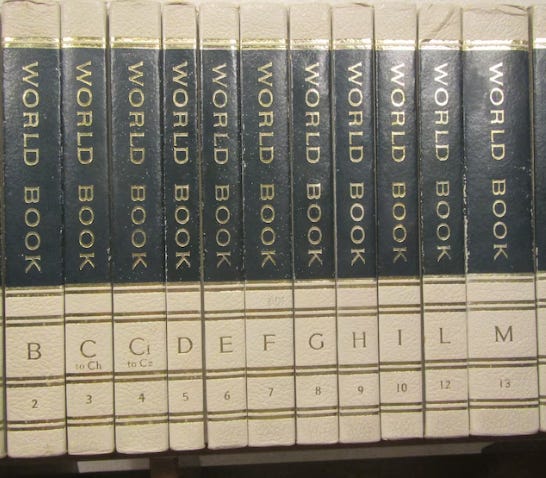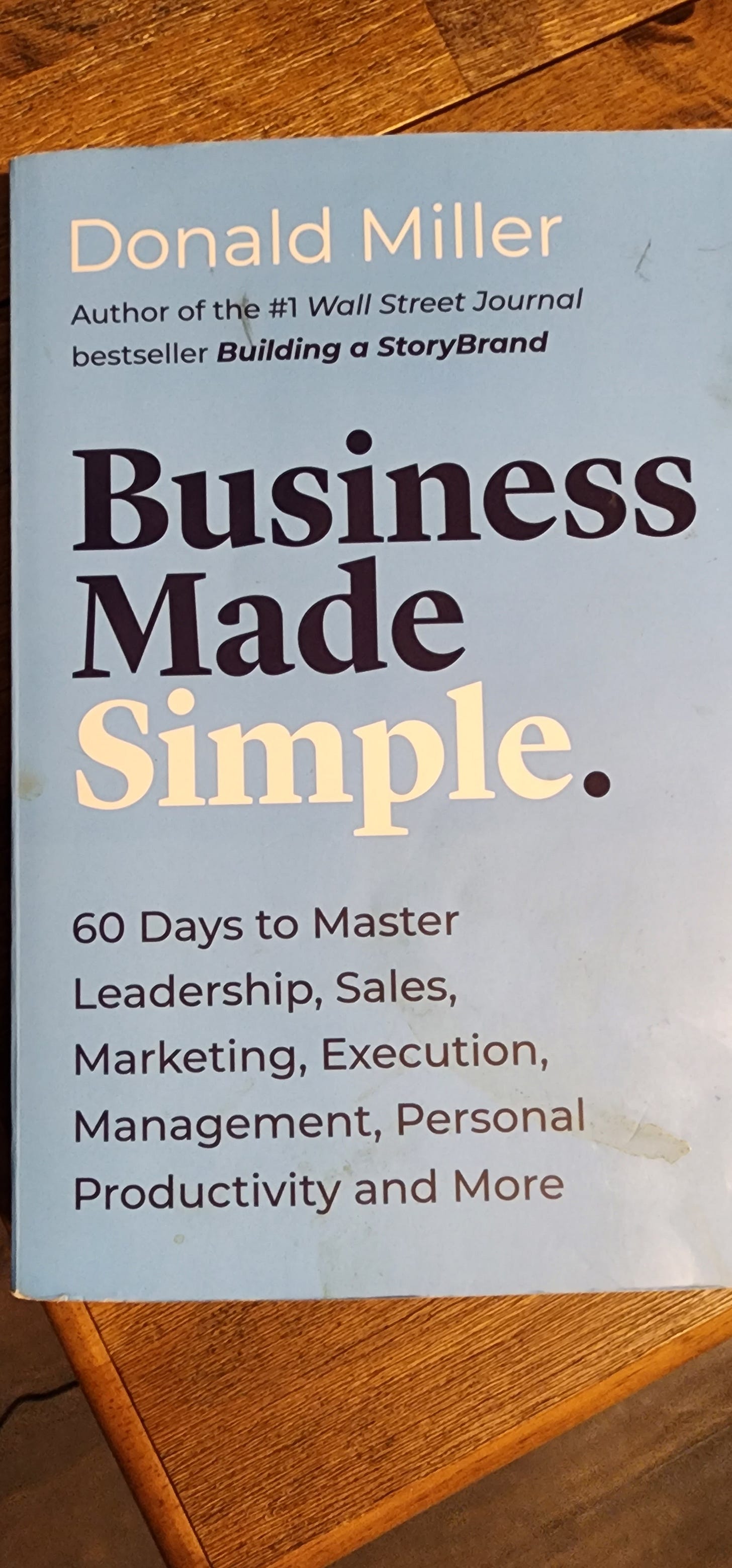3 Easy-to-Read Books That Will Make You Rethink Your Habits, Business, and What It Means to Be Original
Books have always had an outsized impact on my life. Business Made Simple, The Power of Habit, and Steal Like an Artist have recently rejiggered the way I think about a few things.
It was the “G” edition of a 1970s World Book Encyclopedia set at my Meme and Pawpan’s that first turned me on to the power of books.
I was 8-ish years old and hanging with the grandparents in their living room. For whatever reason, “Gettysburg” came up and I asked about it. Meme got out of her Lay-Z-Boy, walked over to the built-in shelves, pulled the book off the shelf, and flipped to “Gettysburg.”
I was enthralled by the painting at first. The accompanying image was a piece from the Cyclorama painting of Pickett’s Charge.* I’ve been interested in Civil War and military history ever since. Another thing this simple exchange did was cement in my head a life-long thought that “you can find the answer in a book.”
As an introvert, that idea has always been appealing – answers without asking someone? Yes, please!
I’ve been inspired by more books than I can easily remember. Here are three, alphabetically, that have changed my thinking recently:
Business Made Simple by Donald Miller
The Power of Habit by Charles Duhigg
Steal Like an Artist by Austin Kleon
Business Made Simple
It’s only in the past year I started thinking seriously about “business.”
I grew up with a simple view of work/career – do good work, get rewarded. For years, I had a piece of “wisdom” stuck in my head about “squeaky wheels.” They get replaced, not greased.
That simplistic view didn’t survive for too long in the workforce. I’m sure we all have stories we could share about watching incompetent people fail up. (If you don’t have that story, we’re all talking about you.)
While I do believe in the basic equation of “do good work, get rewarded;” we all know it doesn’t work exactly like that. A good salesperson could sell you a product/service that’s not a good fit for what you need. Inferior products often do well in the market because of good marketing campaigns.
Not understanding how business works has hurt my career.
Business Made Simple (Miller’s StoryBrand is also excellent, actually, it’s a better book and a perfect companion to your favorite content marketing book) created one small, significant shift in my perspective:
I’m a business.
Or, as he puts it, “Value-driven professionals see themselves as an economic product on the open market.”
They are “obsessed with getting people a strong return on the investment made in them.”
I have always done my best to provide value for my paycheck, but this is a level beyond that. Even when you’re working as an employee, you’re still working for yourself.
The book also does a good job of simply outlining and explaining the elements that make a successful business.
The book is divided into 60 sections, each intended to be read daily. The sipping over guzzling approach is nice. The accompanying videos for each of the daily “lessons” help reinforce the written word (and vice versa if you watch the video first).
The Power of Habit
I’ve struggled with procrastination for my entire life. Literally my entire life.
Over the years, I’ve read different time management books, books on happiness, self-improvement, . . . you know the drill. I’ve taken bits and pieces, but none ever settled in with me.
As I type this, I haven’t finished this one yet.
Even so, it changed my POV.
Habits are habits because our brain is lazy and wants shortcuts. But habits aren’t destiny. The brain can be rewired. You can make new connections.
Also, motivation is for suckers. Habits and processes are the only way to transform your life.
It was in reading this book earlier this year that my resistance to scheduling my days finally crumbled. As I’ve made a habit the last month to use my planner to plot my day, my productivity has improved. (I wanted to say “skyrocketed,” but that would’ve been a lie – by January, I’ll be able to say “skyrocketed” though!)
The first pages of the book grabbed me. A woman had changed her habits and was part of an experiment which involved brain scans. As her new habits kicked in, brain scans showed more and more activity in a formerly inactive area of her brain. It was literally the brain rewiring itself.
That was my “a-ha!” moment that shifted my thinking of habits as just part of who we are to habits are voluntary parts of who we are. We can create the habits that we want.
There aren’t any excuses for remaining in a bad habit if you – deep down – want to change it.
Tiny Habits is also fantastic. To me, it’s also easier to act on with more practical advice. However, it was the Power of Habit that made me receptive to the guidance in Tiny Habits.

Steal Like an Artist
How many times have you had what you thought was unique insight only to realize someone else beat you to it? Sometimes by a couple of hundred years.
I used to always think that you have to be original. It’s been one of the biggest drivers of my procrasticanition – this thing I’m working on has to say something new!
Well, there’s really is nothing new under the sun.
We all build on the works of others.
I’ve written the same basic introductory article about document management 30 or so times over the last 20 years. The content in them isn’t much different from content in the basic business value of this technology for business from the research I did on existing articles in the 90s. Companies in the IDP (intelligent document processing) are still writing variations of this article.
And that’s OK.
I enjoy museums. The Baltimore Museum of Art is a current favorite. I’ve been tramping through the various Smithsonians a few times a year (pre-COVID) since I moved to the MD/DC metro area in 1994. I’m not an art critique – pretty/not pretty is my default setting.
Even so, when you see the works of Monet, Manet, Picasso, Matisse (huge collection at BMA), and others near each other; you begin to see how they influenced each other and later generations. (Reading the signs and such is helpful here!)
It’s taken me a long time to get here, but combining thoughts from someone else is original.
Extending someone’s work is original.
An homage to someone else’s work can be original.
Your interpretation of ancient wisdom could be the unique twist that lights a fire in someone else (even if they’ve already been exposed to the same concept).
I’d encourage anyone stuck with feelings of “I’ve got nothing new to say” to read this book.
Too Many Books Can Be a Bad Thing
I love to read.
When it comes to getting shit done; that’s not always been a great thing.
I struggle with the balance between learning and doing because there is ALWAYS just one more thing to learn.
For me, the biggest benefit of joining The Writers’ League has been the emphasis on action. To rip off a line from academia: publish or perish.
Me, I’m tired of perishing.
I’ve no pithy parting advice to wrap this up beyond be open to inspiration from anywhere while not allowing your quest to “be inspired” to keep you from getting shit done.
Are you ready for more customers? Let’s talk about how content marketing can attract more customers for you; bduhon@simplyusefulmarketing.co.
*And now an historical note for anyone interested. ”Pickett’s Charge” should more appropriately be called Longstreet’s Assault given that Pickett’s division was only half of the Confederate soldiers who made the charge (Pettigrew from North Carolina lead the other – the Virginia press lionized Pickett and his men – Virginians – and disparaged other units in the attack. Vanity and partisanship have a long, “distinguished” history in the U.S. and the press). Anyway, I digress.
The Cyclorama can still be seen at the Gettysburg Park HQ. It is quite something to see – a 360-degree painting of scenes from the battle the height of an IMAX screen. For best viewing conditions, avoid the summer months and hot, bored children being dragged in against their will.
If you are a student of history, Gettysburg is a must. There’s something about standing where Joshua Chamberlain and the men of the 10th Maine stood and thinking about the desperation of a bayonet charge by a few hundred men that arguably changed the world. Or standing on either Seminary Ridge (the Confederate lines) or Cemetery Ridge (the Union) and being in a place where world history tilted in a different direction.
This link from the National Park Service has photos and a short history of the painting.




